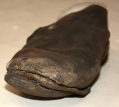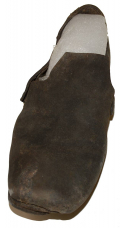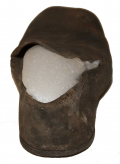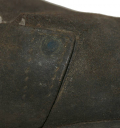site search
online catalog
SCARCE CIVIL WAR ISSUE SHOE ALTERED TO CAMP/BARRACKS SHOE
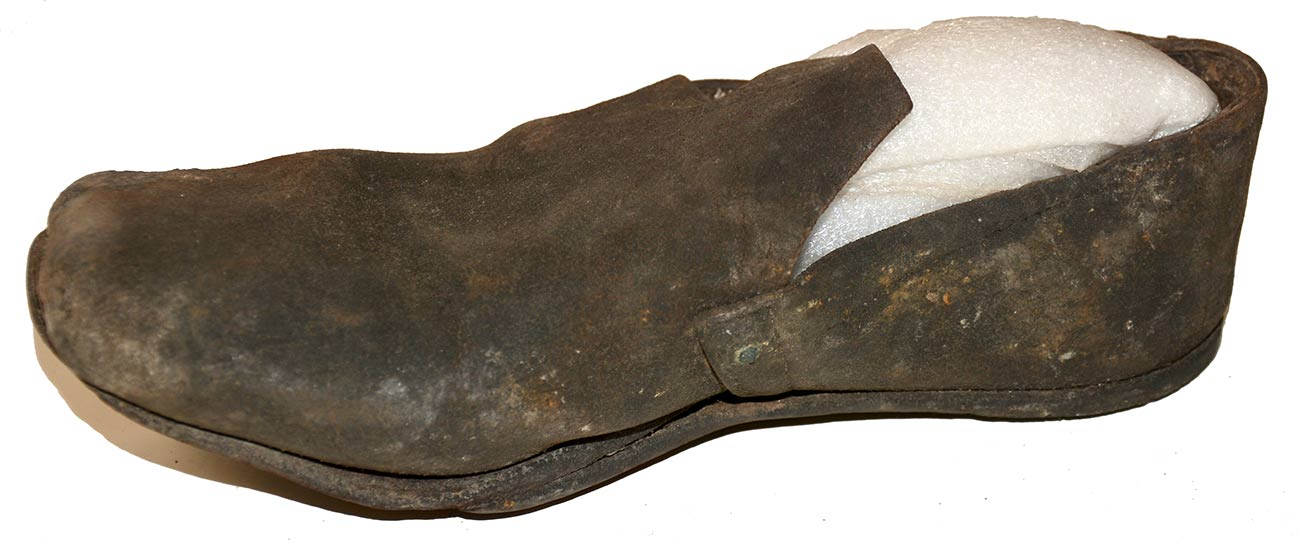
$1,295.00
Quantity Available: 1
Item Code: 1052-426
Shipping: Determined by Method & Location of buyer
To Order:
Call 717-334-0347,
Fax 717-334-5016, or E-mail
The army did not issue “post,” “barracks,” or “camp” shoes until the 1880s. Before that it was up to soldiers to privately purchase or improvise footwear that might prove more comfortable than issue field shoes or boots when off duty or on a fatigue task where non-regulation gear might pass. This is a Civil War issue shoe that was altered to a simple loafer, to use a modern term, by a soldier who cut away the upper rear part of the quarters a little above the line of stitching securing the counter inside the heel of the shoe. This did away with shoelace holes, but he left the tongue intact and the shoe became an easy slip-on-slip-off style.
The construction is typical Civil War, using black leather, rough-side-out uppers with the vamp and quarters joined by stitching with a reinforcing rivet at either side at the instep. Part of the counter, sewn inside the heel remains. The rivets at the instep are in place, showing lots of green, and the leather is stiff, so the vamp and quarters are still in place and tight. The sole is has a very square toe, but enough contour overall to show it was a right shoe, and shows two lines of holes indicating the sole was pegged (one of two standard methods of attaching the sole in the Civil War,) and was fitted at on the underside of the instep with three small copper or brass rivets or pins on either side to reinforce the wood pegs. Two are present on one side and one on the other. The wood pegs are long gone, but sole and uppers are together and tight. The heel, which was nailed in place, is missing, perhaps the reason the shoe was converted or was removed for comfort when the shoe was modified. The sole is good, but the outer sole is missing a strip about ½ inch wide and 3 ½ inches long that would be along the right big toe and ball of the foot. This has disclosed the inner sole, which the same lines of holes for the pegs. The outer sole along that edge shows some rounding, indicating it was likely the reason the shoe was altered, and that is was then used for some time thereafter. About 1 inch of the edge of the inner sole is bent down slightly, creating a little gap between it and the lower edge of the vamp, but the two are still firmly together. This shoe is very similar to the pair of shoes illustrated on page 191 of Arms and Equipment of the Union, identified to a soldier from the 5th Massachusetts, with the rivets noted as a mid-war improvement in the pattern. See also J. Tobey’s article in the Columbia Rifles Research Compendium, labeled example “C” and Peterkin’s Summer 1995 article in the Military Collector and Historian 47.2.
The shoe is in very good condition, black in color, shading slightly to brown, with some scattered thin, gray and brown stains, a spot of thin dried liquid of some sort on top of the right toe, and dust and dirt. The leather is stiff and holds together well, displays very nicely and can be handled. This could be taken for an attic or barn-find from its condition, but was in fact excavated (on private property with the owner’s permission) at Fort Pembina, ND, and was preserved in great condition due to the anaerobic, wet conditions of the dig, which has produced both cloth and leather gear in remarkable states of preservation. (Think of the excellent condition Roman army finds from similar soil conditions in Britain.)
The fort was situated in the Red River Valley in North Dakota near the Canadian border. Trading posts existed earlier in the area as part of the fur trade, and the first U.S. military post there was temporary- manned by a detachment of Minnesota troops in 1863-1864 following the 1862 Sioux uprising. In March 1870 a new fort was established south of the Pembina River and about 200 yards west of the Red River, completed by July and named in honor of Gen. George H. Thomas. The name was changed to Fort Pembina in September and the initial garrison consisted of two companies of the 20th US Infantry. Their main purpose was to provide security for settlers worried about Sioux returning south from Canada, but much of their duty involved escorting boundary surveys along the Canadian border and preventing Fenian raids heading north into Canada. As was typical of the U.S. Army in those early postwar years, uniforms and equipment were being issued from surplus Civil War stocks. It was not until 1872 that some styles and patterns began to change, and even then Civil War material was issued as much as possible to save money and warehouse space. In the case of footwear, the pattern changed in 1872 when the army introduced brass screws as a method of attaching the soles after campaigns on the dry and rocky ground of the southwest revealed problems with sewn and pegged soles on shoes and boots.
The fort included enlistedmen’s barracks, officers’ quarters, guard house, ordnance storehouse, company kitchen, root house, laundress’s quarters, quarters for civilian employees, hospital and hospital servant’s house, a barn for the “hospital cow,” quartermaster and commissary offices and storehouse, stables, wagon shed, etc. The garrison reached peak strength in 1878 of 200, but the average was about 125 enlisted men and 8 officers. An October 1885 return listed 97 men, 2 field pieces, 1 mountain howitzer, 100 rifles, 19 pistols, 23 mules, and 9 wagons. By 1890 the post had just 23 men, and after an 1895 fire destroyed some 19 buildings it was decided to abandon the fort rather than rebuild, the last detachment left in September. The property was turned over to the Interior Department and later sold in 1902.
Army shoes and boots of the period are very scarce- they were hardly the sort of thing to be preserved by a soldier for sentimental reasons or treasured by a family in honor of the veteran’s service. Nevertheless, they were an essential piece of gear and this one has a good connection to the Civil War and early postwar frontier army. It is also nice example of how a soldier at frontier post salvaged what he could from government issue and altered it a bit for personal comfort even, or perhaps especially, at a remote post. [sr] [ph:L]
~~~~~~~~~~~~~~~~~~~~~~~~~~~~~~~~~~~
THIS ITEM, AS WITH ALL OTHER ITEMS AVAILABLE ON OUR WEB SITE,
MAY BE PURCHASED THROUGH OUR LAYAWAY PROGRAM.
CLICK HERE FOR OUR POLICIES AND TERMS.
THANK YOU!
Inquire About SCARCE CIVIL WAR ISSUE SHOE ALTERED TO CAMP/BARRACKS SHOE
For inquiries, please email us at [email protected]
Most Popular
Historical Firearms Stolen From The National Civil War Museum In Harrisburg, Pa »
Theft From Gravesite Of Gen. John Reynolds »
Cavalry Carbine Sling Swivel »
Fine Condition Brass Infantry Bugle Insignia »
featured item
VERY SCARCE 1799-1800 SWAN CONTRACT VIRGINIA MILITIA REGIMENTALLY MARKED MUSKET: 42nd REGIMENT, PITTSYLVANIA
This musket is stamped “42. VA. REGT. PITTSYLVANIA” on the barrel, was later altered to percussion and then shortened for use in the civilian market. It is a scarce survivor from muskets delivered to Virginia by Jame Swan of Boston in January… (1000-241). Learn More »





